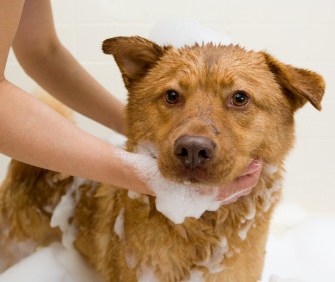How often should you clean your dog’s face? This is one of the questions most dog owners ask. To which a response would be: How often do you wash your face? Try placing yourself in your dog’s shoes, or paws, for a while: shoving your face into a bowl of food and having only your tongue for a napkin; sitting on a curb or walking on the sidewalk with all the car fumes, dust, and debris of the city being swept right into your face; or running in the park on all fours with all the dirt from the ground blowing into your eyes.
Add to this the fact that a dog’s face is often the area most neglected by owners during bathing for fear of getting soap and water into their dog’s eyes, ears, and mouths. You should try to clean your dog’s face as often as possible. Make it a point to wash your dog’s face every time you bathe him, and also make it part of your daily routine to give his face a quick wipe with a moist paper towel or a wet wipe after each walk outside or run in the park.
Again, the head should be the last area to get wet and shampooed and the first area to be rinsed in order to avoid excessive shaking and fewer chances for the shampoo to get into the eyes, ears, and mouth.
The Cleaning Process
Start by scrubbing and massaging the ear flaps with your fingers to help remove any extra oils that have accumulated. While gently holding the head, with the help of a wet washcloth or a small face brush or comb, clean around his eyes, forehead, and chin. Even though special attention should be given to dogs with flat wrinkled faces – like Bulldogs or Pugs – or dogs with short muzzles and bright eyes – like Shih Tzu or Maltese – all dogs can benefit from a few basic cleaning steps to prevent a bacteria-welcoming environment that will result in tear stains.
Stains
The cause of most tear or face stains is bacteria growth in areas that are constantly wet. Also, while small dogs are growing and teething, their skull bones can often shift and their gums can get inflamed causing their small tear ducts to move and get misaligned. This misalignment of the tear ducts will not allow the tears to reach the eyeballs, triggering the production of extra tears and more moisture and thus tear stains.
On dogs with flat faces, tears may not be the only problem. Water from the bowl or saliva from playing with an overly wet plush toy can cause humidity to collect in between the folds and create a bacteria-friendly environment.
The first step of stain removal is to identify the source and nip it in the bud. Your approach can be external, internal, or a combination of both. There are plenty of pet store products, but none of them will work if you don’t take care of the root of the problem first.
Eyes
Externally, always try to keep the eye area clean by using solutions and eye wipes specifically designed for tear stains. The use of powders near the eye area will help from a cosmetic point of view but it could irritate the eyes, making your dog produce extra tears. Some pet products have a small amount of antibiotics, so be sure to consult with your vet before you start treating your dog with these products.
Clean your dog’s eyes with lint-free cotton balls, cotton pads, wipes, or paper towels. Never scrub while the coat is dry, which can make matters worse by scratching and irritating the area. If your dog has been playing in the sand or in a very dusty area, flush his eyes with an eyewash solution before you wipe. A plastic flea comb can help you safely comb out sand from the eye area.
It doesn’t take much sand or debris to clog the tear ducts and make your dog very uncomfortable. This often triggers them to scratch their faces by rubbing them on the carpet, grass, or—even worse—the street, exposing them to serious eye injuries.
An internal approach, which requires changing the PH of the saliva and tears, has proven very successful. This can be achieved by supplementing the dog’s food or water with an alkaline agent such as calcium, potassium, or organic apple vinegar, which will help to stop the growth of bacteria.
Regardless of whether you saw any shampoo drip into the eyes or not, it is a good safety measure to rinse the eyes with a plain eyewash solution. If necessary, follow up with a second shampooing, which will leave the coat squeaky clean, making it easier to trim. This is especially helpful for dogs with extremely oily coats and dogs that get very dirty.

